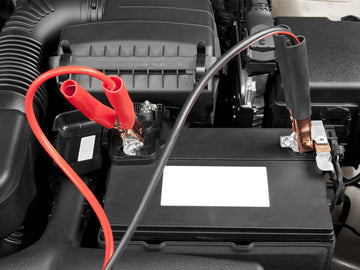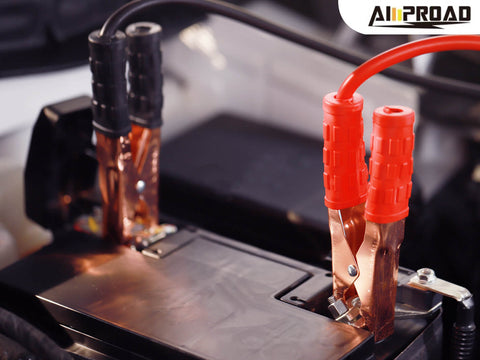
A portable jump starter is a compact device designed to provide a quick boost of power to start a vehicle with a depleted battery, offering a convenient solution for drivers facing unexpected battery failures. It functions by storing electrical energy in an internal battery, which can then be transferred to the vehicle's battery via jumper cables. This jump-starting process enables the vehicle's engine to crank and start, allowing the driver to resume their journey without the need for assistance from another vehicle or roadside service.
Portable jump starters typically consist of several key components, including a battery pack, jumper cables with clamps, and safety features such as reverse polarity protection and overload protection. The battery pack is the heart of the device, storing the electrical energy necessary to jump-start a vehicle. Jumper cables are used to connect the portable jump starter to the vehicle's battery, allowing the transfer of power. Clamps attached to the end of the jumper cables securely connect to the battery terminals. Additionally, modern portable jump starters often come equipped with built-in safety features to prevent damage to the vehicle's electrical system or injury to the user. These features may include reverse polarity protection, which prevents damage caused by incorrect cable connections, and overload protection, which safeguards against excessive current flow. Overall, these components and features work together to provide a reliable and user-friendly solution for jump-starting vehicles in emergencies.
How Does a Portable Jump Starter Work?
Portable jump starters provide a simple and effective solution for jump-starting vehicles, offering peace of mind in emergency situations. But how do they work?
The jump-starting process
These devices operate on the principle of transferring power from the jump starter's internal battery to the vehicle's dead battery, providing the necessary voltage to start the engine. The process begins by connecting the jump starter's cables to the corresponding terminals on the vehicle's battery.
Safety features built into portable jump starters
Once properly connected, the jump starter delivers a surge of power to the battery, effectively boosting it and allowing the engine to start. One of the key features of portable jump starters is their built-in safety mechanisms, designed to prevent damage to the vehicle's electrical system and ensure user safety.
These safety features typically include protections against reverse polarity, overcharging, and short circuits. Reverse polarity protection prevents damage caused by incorrect cable connections, while overcharging protection safeguards the battery from excessive voltage. Additionally, some jump starters feature spark-proof technology, which reduces the risk of sparks when connecting the cables.
How to Connect a Portable Jump Starter and Boost a Car
First, ensure that both the vehicle and the jump starter are turned off. Next, connect the positive (red) clamp of the jump starter to the positive terminal of the vehicle's battery, then connect the negative (black) clamp to a suitable grounding point on the vehicle's chassis, away from the battery. Once the connections are secure, power on the jump starter and attempt to start the vehicle. If successful, allow the engine to run for a few minutes to recharge the vehicle's battery.
Ultimately, portable jump starters offer a straightforward and reliable method for jump-starting vehicles in emergencies. By understanding how they work and following proper safety procedures, you can confidently know how to boost a car using a jump starter and get back on the road quickly and safely.
Can Using a Portable Jump Starter Cause Damage to My Car's Battery?

Jump-starting a car using a portable jump starter is generally safe, but there are potential risks associated with the process that could affect your car's battery health.
Discussion on potential risks associated with jump-starting a vehicle
One risk is the possibility of incorrect connections, which could lead to damage to the vehicle's electrical system. For instance, connecting the jumper cables backward can result in a reverse polarity situation, potentially damaging the battery, alternator, or other electrical components.
Another concern is over-reliance on jump starters. While convenient in emergencies, frequent jump-starting without addressing underlying battery issues or charging system problems can contribute to premature battery wear and failure.
Factors that may contribute to battery damage
Additionally, repeated jump-starting can strain the battery and shorten its lifespan, especially if the battery is already aging or weak. It's essential to address any underlying issues causing the battery to drain repeatedly, such as faulty alternators, parasitic drains, or corroded battery terminals.
Furthermore, using a portable battery booster with insufficient power output for your vehicle's requirements may lead to prolonged cranking times, which can overheat the battery and cause damage.
While portable jump starters are valuable tools for emergency situations, they should be used judiciously and as a temporary solution. It's crucial to address any underlying issues causing the battery to drain and to ensure proper connections and compatibility when jump-starting a vehicle. With proper care and attention, you can minimize the risk of damage to your car's battery when using a portable jump starter.
What Precautions Should I Take When Using a Portable Jump Starter?
When it comes to using a portable jump starter, taking proper precautions ensures a safe and effective jump-starting process for your vehicle.
Safety tips for using a portable jump starter
First and foremost, read the user manual provided with your jump starter to understand its specific safety instructions and guidelines. This manual will outline essential safety precautions and steps to follow for proper operation.
Next, inspect the jump starter for any visible damage or defects before use. Check the cables, clamps, and housing for signs of wear, fraying, or corrosion. Using a damaged booster batterie can pose safety risks and may result in electrical hazards.
Always wear appropriate safety gear, such as gloves and eye protection, when handling the jump starter and working around the vehicle's battery. This precaution helps protect against accidental shocks and exposure to battery acid.
Steps to follow when jump-starting a vehicle
Before connecting the jump starter, ensure that both the vehicle and the jump starter are turned off. This prevents accidental sparks and electrical shorts during the connection process.
Identify the positive and negative terminals on the vehicle's battery. The positive terminal is typically marked with a (+) symbol and may be red, while the negative terminal is marked with a (-) symbol and may be black.
Attach the red (positive) clamp of the jump starter to the positive terminal of the vehicle's battery. Then, connect the black (negative) clamp to a suitable grounding point on the vehicle's chassis, away from the battery. Once the connections are secure, power on the jump starter and attempt to start the vehicle. If successful, allow the engine to run for a few minutes to recharge the vehicle's battery.
Following these safety precautions and steps when using a portable jump starter helps ensure a smooth and hazard-free jump-starting process. By taking the necessary precautions and following proper procedures, you can safely and effectively jump-start your vehicle whenever needed.
How to Choose the Right Portable Jump Starter for Your Vehicle?

When it comes to selecting a portable jump starter for your vehicle, several factors come into play to ensure you choose the right one that meets your needs.
Factors to consider when selecting a portable jump starter
First and foremost, consider the power capacity and peak current output of the jump starter. This determines the strength of the jump-starting capabilities and the types of vehicles it can effectively boost. Look for a jump starter with sufficient power to handle your vehicle's engine size and battery specifications.
Next, pay attention to safety features incorporated into the car booster pack Features such as reverse polarity protection and spark-proof technology help prevent accidents and damage to the vehicle's electrical system during the jump-starting process.
Consider additional functionalities offered by the jump starter, such as USB ports for charging devices and built-in flashlights. These features add versatility and convenience to the jump starter, making it a useful tool for emergency situations beyond jump-starting a vehicle.
Comparison of different portable jump starter models and brands
With a wide variety of portable jump starter models and brands available on the market, it's essential to compare their specifications, features, and user reviews. Look for reputable brands known for their quality and reliability in producing jump starters.
Consider the size and weight of the jump starter, as well as its portability and storage options. A compact and lightweight design makes it easier to carry and store the jump starter in your vehicle or emergency kit.
Evaluate the warranty and customer support offered by the jump starter manufacturer. A longer warranty period and responsive customer service can provide peace of mind and support in case of any issues or concerns with the product.
User reviews and ratings can provide valuable insights into the performance and reliability of a portable jump starter. Look for reviews from other vehicle owners who have used the jump starter in real-life situations to gauge its effectiveness and durability.
When making your decision, you may come across brands like Amproad, which offer reliable jump starters with a range of features designed to meet various needs. Consider all these factors to select the right portable jump starter for your vehicle, ensuring it provides the power and reliability you need when faced with a dead battery.
FAQs / People also Ask
Is it possible to overcharge a portable jump starter?
Most modern portable jump starters come with built-in protection features to prevent overcharging and extend the battery's lifespan. However, it's still essential to follow the manufacturer's instructions and avoid leaving the jump starter connected to a power source for an extended period.
Can I use a portable jump starter to charge other devices, such as smartphones or tablets?
Many portable jump starters come equipped with USB ports or other power outlets, allowing them to double as a portable power bank for charging electronic devices. However, it's essential to check the specifications of your jump starter to ensure compatibility and avoid damaging your devices.


